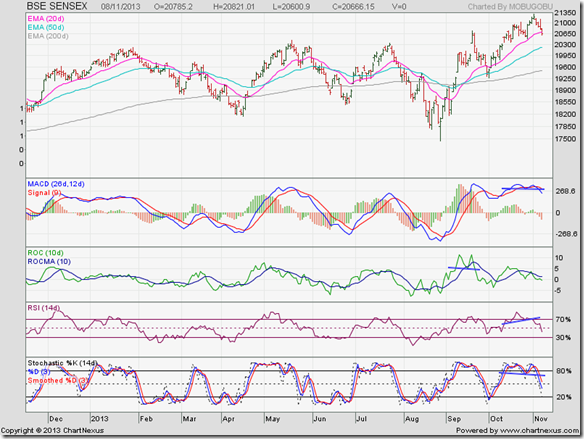After touching lifetime highs, both Sensex and Nifty indices retreated during a Diwali holiday-shortened trading week. Bears (read: DIIs) booked profits. FIIs remained net buyers, but were overwhelmed by the strong volume of DII selling.
Better than expected GDP growth in the USA and Dollar buying by PSU oil firms led to a weaker Rupee. Gold’s price dropped on fears of QE3 tapering sooner than later due to signs of strength in the US economy.
Tech Mahindra and Tata Motors announced strong Q2 results. However, stand-alone numbers of Tata Motors were disastrous. Domestic passenger vehicle and commercial vehicle sales nose-dived. A pick up in CV sales will be an indication of a recovering economy.
BSE Sensex index chart
In last week’s analysis, negative divergences were observed in all four technical indicators and overbought conditions in three of the four indicators led to the following remarks: “A few days of correction/consolidation will remedy the overbought condition and improve the technical ‘health’ of the chart pattern. The likely dip will be another opportunity to add.”
All four technical indicators also formed reversal patterns in their overbought zones, with MACD, ROC and Slow stochastic forming double-tops and RSI forming a head-and-shoulders pattern. So, will all these technical headwinds end the bull market?
The short answer is: No. Bull markets usually end in euphoria, with stock tips flooding the Internet and every one and his brother-in-law buying junk stocks. There is not even an iota of any euphoria. On the contrary, experts have already started predicting much lower levels for the index.
The correction may last a little longer and go a little deeper, but it should remain a bull market correction that is providing an opportunity to add.
NSE Nifty 50 index chart
The weekly bar chart pattern of NSE Nifty is in the midst of another bull market correction, but is trading above both its 20 week and 50 week EMAs and the long-term up-trend line (in blue). Such corrections help the index to gather strength for the next up move, and also offer opportunities for adding to existing holdings.
Weekly technical indicators are bullish, but beginning to correct from overbought conditions. Some more correction may be on the cards. Is this a good time to enter the market for new investors?
A good time to enter the market is when you have the money. Index level wise, Jun ‘12 and Aug ‘13 were better times to enter. But one needs courage, conviction and experience to buy during sharp dips.
Note that the up-trend is almost 2 years old. Low-hanging fruits have already been plucked. Most new investors would be better off regularly investing a part of their monthly savings in a recurring deposit scheme and a part in a balanced fund. Gain experience and knowledge before jumping into the stock market.
Bottomline? Chart patterns of BSE Sensex and NSE Nifty indices are in corrective modes after touching life-time highs. Many fundamentally strong mid-cap and small-cap stocks are still available at reasonable valuations – provided one takes a longer-term view of the market. Such stocks can be accumulated gradually.
(Note: If you are interested to learn more about fundamentally strong mid-cap and small-cap stocks, become a paid subscriber of my Monthly Investment Newsletter. A limited number of new subscriptions will be offered during Jan. 2014.)


3 comments:
Dear Sir,
I have a question about NRI FD combined with MF SIP! I am a NRI from Gulf.
I have a sufficient portion of money in equity funds and for the debt portion, I was investing in debt funds for the asset allocation and as well as for better post tax returns from debt funds.
Now NRE FD’s provide a tax free return of 9% on a 10year deposit.
Is it not a wise decision to lock in the debt portfolio in such long term deposits and take the quarterly interest and invest in a quality equity mutual fund and shun totally the debt funds which going by their past records never registered a 9% returns on a 10year period. This way the capital is protected (no need to get fooled by CAPITAL PROTECTION FUND of MF). A guranteed 9% deposit from a bank like SBI is too good for a debt folio (even MIPS provide that much return only in long term and still tax have to be paid).
Lets say if I invest 50Lacs in 10Year FD @ 9%, the quaterly interest is approx. 111,000Rs. If the same amount is invest in pure equity funds (lets say quarterly or monthly as 37500), the returns from the equity fund should be atleast 12 – 14% in a 10year time frame and the capital of 50Lacs is safe as well. This return will be more than the cumulative FD return of approx 1.2Crore in 10Years.
Is my judgement is correct or am I missing anything.
In otherwords, how should one invest 50Lac safely without taking too much risk however maximising the return, given a scenario where the NRE FD is tax free?
Regards
You haven't missed anything, Ajay.
A slightly more conservative strategy was posted 5 years ago. You can read it at the following link:
http://investmentsfordummieslikeme.blogspot.in/2008/10/start-your-own-risk-free-fmp.html
Thanks a lot for your feedback.
Post a Comment